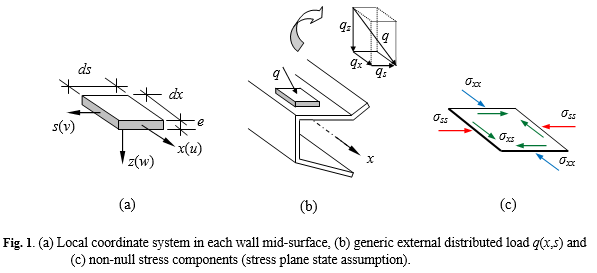Generalised beam theory
This article, Generalised beam theory, has recently been created via the Articles for creation process. Please check to see if the reviewer has accidentally left this template after accepting the draft and take appropriate action as necessary.
Reviewer tools: Inform author |
 Comment: Not entirely certain of its notability but this will also still need any further available in-depth third-party sources overall. SwisterTwister talk 07:50, 13 February 2016 (UTC)
Comment: Not entirely certain of its notability but this will also still need any further available in-depth third-party sources overall. SwisterTwister talk 07:50, 13 February 2016 (UTC)
GBT comes from "Generalised Beam Theory" and is the most complete and dissiminated beam theory ever formulated and extensively validated. Its origin is due to Richard Schardt (1966), a German Scientist from the University of Darmstadt. Since then many other authors have extended the initial (first-order elastic) GBT formulations developed by Schardt and his co-workers[1][2]. However, it is fair to say that a vast majority of the most advanced/complete (in order to predict as close as possible the real behaviour (collapse and post-collapse) of a structural member) formulations and applications of GBT have been developed by the research group headed by Dinar Camotim, a full professor from the University of Lisbon, Portugal, since the beginning of the 21st century (please follow the website of his research group for information on publications and available software).
The theory can be applied without restrictions to any prismatic thin-walled structural member exhibiting straight or curved axial axis (any loading, any cross-section geometry, any boundary conditions), and it is a very promising alternative to the powerful Finite Element Method employing 2D or 3D FEs to predict the member structural behaviour.
GBT has already been widely recognised as a powerful, versatile, elegant and efficient approach to analyse thin-walled members and structural systems. The elegance and efficiency arise mostly from its rather unique modal nature – the displacement field is expressed as a linear combination of cross-section deformation modes whose amplitudes vary continuously along the member length (x axis) - see Figures 2-3. Due to GBT assumptions inherent to a thin-walled member, only 3 non-null stress components are considered in the formulations (see Fig. 1).
Membrane displacement field (i.e., in the cross-section mid-surface): ![]()
The GBT modal nature makes it possible to (i) acquire in-depth knowledge on the mechanics of the thin-walled member behaviour and (ii) judiciously exclude, from subsequent similar GBT analyses, those deformation modes found to play no (or negligible) role in the particular behaviour under scrutiny, thus further reducing the number of d.o.f. involved in a GBT analysis (i.e., increasing its computational efficiency). GBT has already extensively prooved its potential regarding (1) deep understanding of the structural behaviour under analysis as well as (2) computational efficiency (i.e., number of degrees of freedom involved in the analysis) - results and a more detailed insight of GBT-based inelastic analyses are available online (check out works from Dinar Camotim, Nuno Silvestre, Pedro B. Dinis, Rodrigo Gonçalves, Cilmar Basaglia, Rui Bebiano, Nuno Silva and Miguel Abambres).
The investigation, application and dissemination of GBT will certainly last during many more years.



